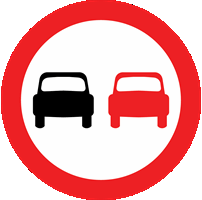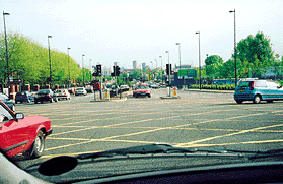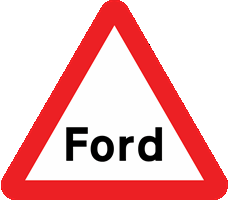You have 57 minutes to answer 50 multiple choice theory test questions. You need to answer at least 43 out of 50 questions correctly to pass. You can review your answer after each question or you can review all of your answers at the end of the test. Best of luck!
Test Quick View
Click on an answer to view the correct choice along with the explanation.
Correct Answer: D
Explanation: These signs only apply to trams. They are directed at tram drivers but you should know their meaning so that you're aware of the priorities and are able to anticipate the actions of the driver.
Explanation: These signs only apply to trams. They are directed at tram drivers but you should know their meaning so that you're aware of the priorities and are able to anticipate the actions of the driver.
Correct Answer: A
Explanation: Your horn must not be used between 11.30 pm and 7 am in a built-up area or when you are stationary, unless a moving vehicle poses a danger. Its function is to alert other road users to your presence.
Explanation: Your horn must not be used between 11.30 pm and 7 am in a built-up area or when you are stationary, unless a moving vehicle poses a danger. Its function is to alert other road users to your presence.
3. You are coming up to a roundabout. A cyclist is signalling to turn right. What should you do?
Mark one answer
B
C
D
Correct Answer: B
Explanation: If you're following a cyclist who's signalling to turn right at a roundabout leave plenty of room. Give them space and time to get into the correct lane.
Explanation: If you're following a cyclist who's signalling to turn right at a roundabout leave plenty of room. Give them space and time to get into the correct lane.
Correct Answer: A, B
Explanation: Don't pass riders too closely as this may cause them to lose balance. Always leave as much room as you would for a car, and don't cut in.
Explanation: Don't pass riders too closely as this may cause them to lose balance. Always leave as much room as you would for a car, and don't cut in.
5. There is a slow-moving motorcyclist ahead of you. You are unsure what the rider is going to do. You should
Mark one answer
B
C
D
Correct Answer: D
Explanation: If a motorcyclist is travelling slowly it may be that they are looking for a turning or entrance. Be patient and stay behind them in case they need to make a sudden change of direction.
Explanation: If a motorcyclist is travelling slowly it may be that they are looking for a turning or entrance. Be patient and stay behind them in case they need to make a sudden change of direction.
B
C
D
E
Correct Answer: A, B
Explanation: Only overtake the vehicle in front if it's really necessary. At night the risks are increased due to the poor visibility. Don't overtake if there's a possibility of
- road junctions,
- bends ahead,
- the brow of a bridge or hill, except on a dual carriageway,
- pedestrian crossings,
- double white lines ahead,
- vehicles changing direction,
- any other potential hazard.
Explanation: Only overtake the vehicle in front if it's really necessary. At night the risks are increased due to the poor visibility. Don't overtake if there's a possibility of
- road junctions,
- bends ahead,
- the brow of a bridge or hill, except on a dual carriageway,
- pedestrian crossings,
- double white lines ahead,
- vehicles changing direction,
- any other potential hazard.
Correct Answer: B
Explanation: You should give way to traffic already on the motorway. Where possible they may move over to let you in but don't force your way into the traffic stream. The traffic may be travelling at high speed so you should match your speed to fit in.
Explanation: You should give way to traffic already on the motorway. Where possible they may move over to let you in but don't force your way into the traffic stream. The traffic may be travelling at high speed so you should match your speed to fit in.
Correct Answer: B
Explanation: A red slash through this sign indicates that the restriction has ended. In this case the restriction was a minimum speed limit of 30 mph.
Explanation: A red slash through this sign indicates that the restriction has ended. In this case the restriction was a minimum speed limit of 30 mph.
Correct Answer: B
Explanation: The use of cycles is being encouraged and more toucan crossings are being installed. These crossings enable pedestrians and cyclists to cross the path of other traffic. Watch out as cyclists will approach the crossing faster than pedestrians.
Explanation: The use of cycles is being encouraged and more toucan crossings are being installed. These crossings enable pedestrians and cyclists to cross the path of other traffic. Watch out as cyclists will approach the crossing faster than pedestrians.
Correct Answer: B
Explanation: Road signs that prohibit overtaking are placed in locations where passing the vehicle in front is dangerous. If you see this sign don't attempt to overtake. The sign is there for a reason and you must obey it.
Explanation: Road signs that prohibit overtaking are placed in locations where passing the vehicle in front is dangerous. If you see this sign don't attempt to overtake. The sign is there for a reason and you must obey it.
Correct Answer: D
Explanation: Don't force your way through. Show courtesy and consideration to other road users. Although you have priority, make sure oncoming traffic is going to give way before you continue.
Explanation: Don't force your way through. Show courtesy and consideration to other road users. Although you have priority, make sure oncoming traffic is going to give way before you continue.
12. You see a horse rider as you approach a roundabout. They are signalling right but keeping well to the left. You should
Mark one answer
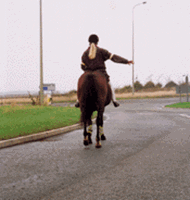
B
C
D
Correct Answer: D
Explanation: Allow the horse rider to enter and exit the roundabout in their own time. They may feel safer keeping to the left all the way around the roundabout. Don't get up close behind or alongside them. This is very likely to upset the horse and create a dangerous situation.
Explanation: Allow the horse rider to enter and exit the roundabout in their own time. They may feel safer keeping to the left all the way around the roundabout. Don't get up close behind or alongside them. This is very likely to upset the horse and create a dangerous situation.
13. You keep well back while waiting to overtake a large vehicle. A car fills the gap. You should
Mark one answer
B
C
D
Correct Answer: A
Explanation: It's very frustrating when your separation distance is shortened by another vehicle. React positively, stay calm and drop further back.
Explanation: It's very frustrating when your separation distance is shortened by another vehicle. React positively, stay calm and drop further back.
14. A horse rider is in the left-hand lane approaching a roundabout. You should expect the rider to
Mark one answer
B
C
D
Correct Answer: B
Explanation: Horses and their riders will move more slowly than other road users. They might not have time to cut across heavy traffic to take up positions in the offside lane. For this reason a horse and rider may approach a roundabout in the left-hand lane, even though they're turning right.
Explanation: Horses and their riders will move more slowly than other road users. They might not have time to cut across heavy traffic to take up positions in the offside lane. For this reason a horse and rider may approach a roundabout in the left-hand lane, even though they're turning right.
Correct Answer: C
Explanation: When stationary only sound your horn if you think there is a risk of danger from another road user. Don't use it just to attract someone's attention. This causes unnecessary noise and could be misleading.
Explanation: When stationary only sound your horn if you think there is a risk of danger from another road user. Don't use it just to attract someone's attention. This causes unnecessary noise and could be misleading.
16. At a crossroads there are no signs or road markings. Two vehicles approach. Which has priority?
Mark one answer
B
C
D
Correct Answer: A
Explanation: At a crossroads where there are no 'give way' signs or road markings be very careful. No vehicle has priority, even if the sizes of the roads are different.
Explanation: At a crossroads where there are no 'give way' signs or road markings be very careful. No vehicle has priority, even if the sizes of the roads are different.
17. Other drivers may sometimes flash their headlights at you. In which situation are they allowed to do this?
Mark one answer
B
C
D
Correct Answer: D
Explanation: If other drivers flash their headlights this isn't a signal to show priority. The flashing of headlights has the same meaning as sounding the horn, it's a warning of their presence.
Explanation: If other drivers flash their headlights this isn't a signal to show priority. The flashing of headlights has the same meaning as sounding the horn, it's a warning of their presence.
18. A bus has stopped at a bus stop ahead of you. Its right-hand indicator is flashing. You should
Mark one answer

B
C
D
Correct Answer: B
Explanation: Give way to buses whenever you can do so safely, especially when they signal to pull away from bus stops. Look out for people leaving the bus and crossing the road.
Explanation: Give way to buses whenever you can do so safely, especially when they signal to pull away from bus stops. Look out for people leaving the bus and crossing the road.
19. You are parking on a two-way road at night. The speed limit is 40 mph. You should park on the
Mark one answer
B
C
D
Correct Answer: B
Explanation: At night all vehicles must display parking lights when parked on a road with a speed limit greater than 30 mph. They should be close to the kerb, facing in the direction of the traffic flow and not within a distance as specified in The Highway Code.
Explanation: At night all vehicles must display parking lights when parked on a road with a speed limit greater than 30 mph. They should be close to the kerb, facing in the direction of the traffic flow and not within a distance as specified in The Highway Code.
Correct Answer: D
Explanation: The picture of a cycle will also usually be painted on the road, sometimes with a different coloured surface. Leave these clear for cyclists and don't pass too closely when you overtake.
Explanation: The picture of a cycle will also usually be painted on the road, sometimes with a different coloured surface. Leave these clear for cyclists and don't pass too closely when you overtake.
B
C
D
Correct Answer: D
Explanation: Where street repairs have closed off pavements, proceed carefully and slowly as pedestrians might have to walk in the road.
Explanation: Where street repairs have closed off pavements, proceed carefully and slowly as pedestrians might have to walk in the road.
Correct Answer: C
Explanation: You MUST NOT enter a box junction until your exit road or lane is clear. The exception to this is if you want to turn right and are only prevented from doing so by oncoming traffic or by other vehicles waiting to turn right.
Explanation: You MUST NOT enter a box junction until your exit road or lane is clear. The exception to this is if you want to turn right and are only prevented from doing so by oncoming traffic or by other vehicles waiting to turn right.
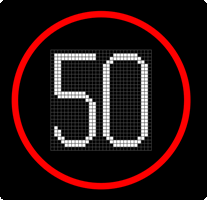
B
C
D
Correct Answer: A
Explanation: A mandatory speed limit sign above the hard shoulder shows that it can be used as a running lane between junctions. You must stay within the speed limit. Look out for vehicles that may have broken down and could be blocking the hard shoulder.
Explanation: A mandatory speed limit sign above the hard shoulder shows that it can be used as a running lane between junctions. You must stay within the speed limit. Look out for vehicles that may have broken down and could be blocking the hard shoulder.
Correct Answer: A
Explanation: Most motoring organisation websites allow you to create a detailed plan of your trip, showing directions and distances. Some also include advice on rest and fuel stops. The Traffic England website will give you information on roadworks and accidents, along with expected delay times.
Explanation: Most motoring organisation websites allow you to create a detailed plan of your trip, showing directions and distances. Some also include advice on rest and fuel stops. The Traffic England website will give you information on roadworks and accidents, along with expected delay times.
25. Planning your journey to avoid busy times has a number of advantages. One of these is
Mark one answer
B
C
D
Correct Answer: B
Explanation: Having a pleasant journey can have safety benefits. You will be less tired and stressed and this will allow you to concentrate more on your driving or riding.
Explanation: Having a pleasant journey can have safety benefits. You will be less tired and stressed and this will allow you to concentrate more on your driving or riding.
Correct Answer: D
Explanation: A ford is a crossing over a stream that's shallow enough to go through. After you've gone through a ford or deep puddle the water will affect your brakes. To dry them out apply a light brake pressure while moving slowly. Don't travel at normal speeds until you are sure your brakes are working properly again.
Explanation: A ford is a crossing over a stream that's shallow enough to go through. After you've gone through a ford or deep puddle the water will affect your brakes. To dry them out apply a light brake pressure while moving slowly. Don't travel at normal speeds until you are sure your brakes are working properly again.
27. A casualty is not breathing normally. Chest compressions should be given. At what rate?
Mark one answer
B
C
D
Correct Answer: B
Explanation: If a casualty is not breathing normally chest compressions may be needed to maintain circulation. Place two hands on the centre of the chest and press down hard and fast - around 5-6 centimetres and about twice a second.
Explanation: If a casualty is not breathing normally chest compressions may be needed to maintain circulation. Place two hands on the centre of the chest and press down hard and fast - around 5-6 centimetres and about twice a second.
B
C
D
Correct Answer: C
Explanation: Stay with the casualty and talk to them quietly and firmly to calm and reassure them. Avoid moving them unnecessarily in case they are injured. Keep them warm, but don't give them anything to eat or drink.
Explanation: Stay with the casualty and talk to them quietly and firmly to calm and reassure them. Avoid moving them unnecessarily in case they are injured. Keep them warm, but don't give them anything to eat or drink.
B
C
D
Correct Answer: D
Explanation: The motorcyclist is in an extremely vulnerable position, exposed to further danger from traffic. Approaching vehicles need advance warning in order to slow down and safely take avoiding action or stop. Don't put yourself or anyone else at risk. Use the hazard warning lights on your vehicle to alert other road users to the danger.
Explanation: The motorcyclist is in an extremely vulnerable position, exposed to further danger from traffic. Approaching vehicles need advance warning in order to slow down and safely take avoiding action or stop. Don't put yourself or anyone else at risk. Use the hazard warning lights on your vehicle to alert other road users to the danger.
Correct Answer: A, D
Explanation: Ensure that you can see clearly through the windscreen of your vehicle. Stickers or hanging objects could affect your field of vision or draw your eyes away from the road
Explanation: Ensure that you can see clearly through the windscreen of your vehicle. Stickers or hanging objects could affect your field of vision or draw your eyes away from the road
Correct Answer: B
Explanation: If you're travelling on an icy road extra caution will be required to avoid loss of control. Keeping your speed down and using the highest gear possible will reduce the risk of the tyres losing their grip on this slippery surface.
Explanation: If you're travelling on an icy road extra caution will be required to avoid loss of control. Keeping your speed down and using the highest gear possible will reduce the risk of the tyres losing their grip on this slippery surface.
Correct Answer: C
Explanation: By driving all four wheels there is improved grip, but this does not replace the skills you need to drive safely. The extra grip helps road holding when travelling on slippery or uneven roads.
Explanation: By driving all four wheels there is improved grip, but this does not replace the skills you need to drive safely. The extra grip helps road holding when travelling on slippery or uneven roads.
B
C
D
Correct Answer: B
Explanation: You have shown that you are a risk to yourself and others on the road. For this reason insurance companies may charge you a higher premium.
Explanation: You have shown that you are a risk to yourself and others on the road. For this reason insurance companies may charge you a higher premium.
34. If you are feeling tired it is best to stop as soon as you can. Until then you should
Mark one answer
B
C
D
Correct Answer: A
Explanation: If you're going on a long journey plan your route before you leave. This will help you to be decisive at intersections and junctions, plan rest stops and have an idea of how long the journey will take.Make sure your vehicle is well-ventilated to stop you becoming drowsy. You need to maintain concentration so that your judgement is not impaired.
Explanation: If you're going on a long journey plan your route before you leave. This will help you to be decisive at intersections and junctions, plan rest stops and have an idea of how long the journey will take.Make sure your vehicle is well-ventilated to stop you becoming drowsy. You need to maintain concentration so that your judgement is not impaired.
35. You want to turn right from a junction but your view is restricted by parked vehicles. What should you do?
Mark one answer
B
C
D
Correct Answer: D
Explanation: If you want to turn right from a junction and your view is restricted, STOP. Ease forward until you can see - there might be something approaching.IF YOU DON'T KNOW, DON'T GO.
Explanation: If you want to turn right from a junction and your view is restricted, STOP. Ease forward until you can see - there might be something approaching.IF YOU DON'T KNOW, DON'T GO.
36. You are waiting at a level crossing. The red warning lights continue to flash after a train has passed by. What should you do?
Mark one answer

B
C
D
Correct Answer: A
Explanation: At a level crossing flashing red lights mean you must stop. If the train passes but the lights keep flashing, wait. There may be another train coming.
Explanation: At a level crossing flashing red lights mean you must stop. If the train passes but the lights keep flashing, wait. There may be another train coming.
Correct Answer: B
Explanation: When there's queuing traffic ahead and you have to slow down or even stop, showing your hazard warning lights will alert following traffic to the hazard. Don't forget to switch them off as the queue forms behind you.
Explanation: When there's queuing traffic ahead and you have to slow down or even stop, showing your hazard warning lights will alert following traffic to the hazard. Don't forget to switch them off as the queue forms behind you.
38. You are driving along this road. The driver on the left is reversing from a driveway. You should
Mark one answer
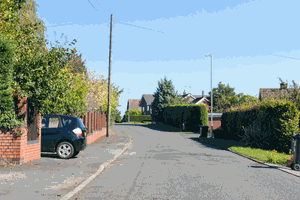
B
C
D
Correct Answer: C
Explanation: White lights at the rear of a car show that it is about to reverse. Sound your horn to warn of your presence and reduce your speed as a precaution.
Explanation: White lights at the rear of a car show that it is about to reverse. Sound your horn to warn of your presence and reduce your speed as a precaution.
Correct Answer: C
Explanation: If you can see valuables in your car so can a thief. If you can't take them with you lock them out of sight or you risk losing them, as well as having your car damaged.
Explanation: If you can see valuables in your car so can a thief. If you can't take them with you lock them out of sight or you risk losing them, as well as having your car damaged.
Correct Answer: A
Explanation: If you have a garage, use it. Your vehicle is less likely to be a victim of car crime if it's in a garage. Also in winter the windows will be free from ice and snow.
Explanation: If you have a garage, use it. Your vehicle is less likely to be a victim of car crime if it's in a garage. Also in winter the windows will be free from ice and snow.
Correct Answer: D
Explanation: Extra care should be taken in wet weather as, on wet roads, your stopping distance could be double that necessary for dry conditions.
Explanation: Extra care should be taken in wet weather as, on wet roads, your stopping distance could be double that necessary for dry conditions.
42. You are driving on a motorway. The car ahead shows its hazard lights for a short time. This tells you that
Mark one answer
B
C
D
Correct Answer: D
Explanation: If the vehicle in front shows its hazard lights there may be an incident or queuing traffic ahead. As well as keeping a safe distance, look beyond it to help you get an early warning of any hazards and a picture of the situation ahead.
Explanation: If the vehicle in front shows its hazard lights there may be an incident or queuing traffic ahead. As well as keeping a safe distance, look beyond it to help you get an early warning of any hazards and a picture of the situation ahead.
43. You are intending to leave the motorway at the next exit. Before you reach the exit you should normally position your vehicle
Mark one answer
B
C
D
Correct Answer: B
Explanation: You'll see the first advance direction sign one mile from the exit. If you're travelling at 60 mph in the right-hand lane you'll only have about 50 seconds before you reach the countdown markers. There will be another sign at the half-mile point. Move in to the left-hand lane in good time. Don't cut across traffic at the last moment and don't risk missing your exit.
Explanation: You'll see the first advance direction sign one mile from the exit. If you're travelling at 60 mph in the right-hand lane you'll only have about 50 seconds before you reach the countdown markers. There will be another sign at the half-mile point. Move in to the left-hand lane in good time. Don't cut across traffic at the last moment and don't risk missing your exit.
Correct Answer: A
Explanation: Some bus lanes only operate during peak hours and other vehicles may use them outside these hours. Make sure you check the sign for the hours of operation before driving in a bus lane.
Explanation: Some bus lanes only operate during peak hours and other vehicles may use them outside these hours. Make sure you check the sign for the hours of operation before driving in a bus lane.
45. You are planning to tow a caravan. Which of these will mostly help to aid the vehicle handling?
Mark one answer
B
C
D
Correct Answer: B
Explanation: Towing a caravan or trailer affects the way the tow vehicle handles. It is highly recommended that you take a caravan manoeuvring course. These are provided by various organisations for anyone wishing to tow a trailer.
Explanation: Towing a caravan or trailer affects the way the tow vehicle handles. It is highly recommended that you take a caravan manoeuvring course. These are provided by various organisations for anyone wishing to tow a trailer.
Correct Answer: B
Explanation: You should always try to keep junctions clear. If you are in queuing traffic make sure that when you stop you leave enough space for traffic to flow in and out of the junction.
Explanation: You should always try to keep junctions clear. If you are in queuing traffic make sure that when you stop you leave enough space for traffic to flow in and out of the junction.
47. You are carrying a child using a rear-facing baby seat. You want to put it on the front passenger seat. What MUST you do before setting off?
Mark one answer
B
C
D
Correct Answer: C
Explanation: You MUST deactivate any frontal passenger airbag when using a rear-facing baby seat in a front passenger seat. It is ILLEGAL if you don't. If activated in a crash it could cause serious injury or death. Ensure you follow the manufacturers instructions. In some cars this is now done automatically.
Explanation: You MUST deactivate any frontal passenger airbag when using a rear-facing baby seat in a front passenger seat. It is ILLEGAL if you don't. If activated in a crash it could cause serious injury or death. Ensure you follow the manufacturers instructions. In some cars this is now done automatically.
B
C
D
Correct Answer: A
Explanation: You should make all efforts to ensure a correct child restraint is used, with very few exceptions. If in specific circumstances one is not available, then an adult seat belt MUST be used. Unrestrained objects, including people, can be thrown violently around in a collision, and may cause serious injury or even death!
Explanation: You should make all efforts to ensure a correct child restraint is used, with very few exceptions. If in specific circumstances one is not available, then an adult seat belt MUST be used. Unrestrained objects, including people, can be thrown violently around in a collision, and may cause serious injury or even death!
B
C
D
Correct Answer: A
Explanation: Never stop on the hard shoulder to rest. If there is no service station for several miles, leave the motorway at the next exit and find somewhere safe and legal to pull over.
Explanation: Never stop on the hard shoulder to rest. If there is no service station for several miles, leave the motorway at the next exit and find somewhere safe and legal to pull over.
50. You are in collision with another moving vehicle. Someone is injured and your vehicle is damaged. Which FOUR of the following should you find out?
Mark four answers
B
C
D
E
F
Correct Answer: A, B, D, E
Explanation: Try to keep calm and don't rush. Ensure that you have all the details before you leave the scene. If possible take pictures and note the positions of all the vehicles involved.
Explanation: Try to keep calm and don't rush. Ensure that you have all the details before you leave the scene. If possible take pictures and note the positions of all the vehicles involved.




